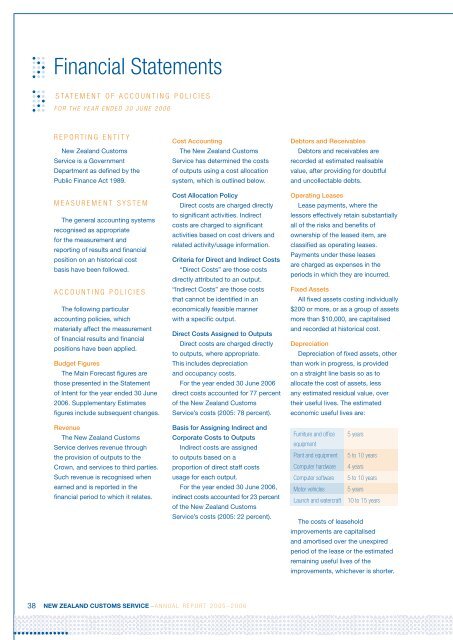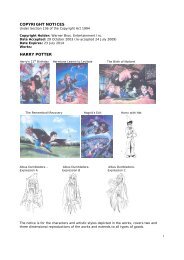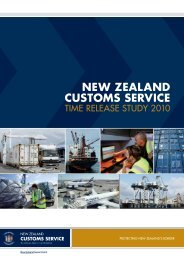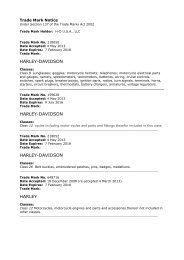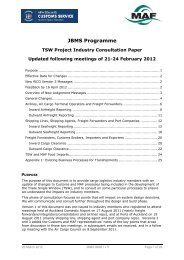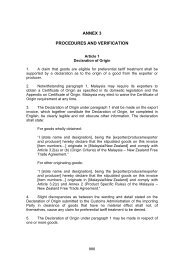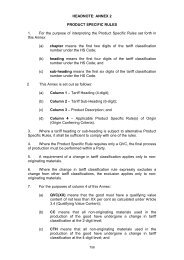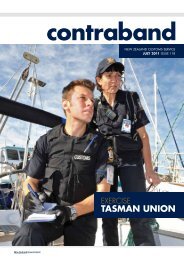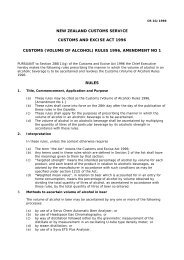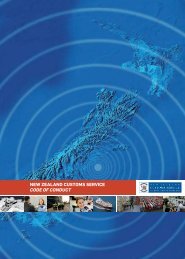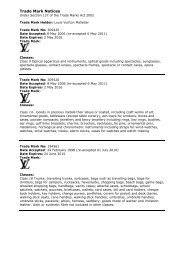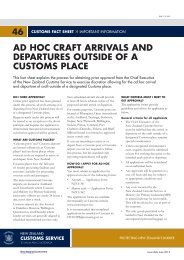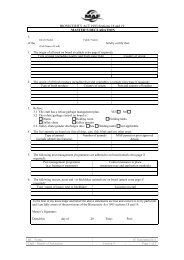Annual Report 2005-2006 - New Zealand Customs Service
Annual Report 2005-2006 - New Zealand Customs Service
Annual Report 2005-2006 - New Zealand Customs Service
You also want an ePaper? Increase the reach of your titles
YUMPU automatically turns print PDFs into web optimized ePapers that Google loves.
Financial Statements<br />
S t a t e m e n t o f A c c o u n t i n g P o l i c i e s<br />
F O R T H E Y E A R E N D E D 3 0 J U N E 2 0 0 6<br />
R e p o r t i n g E n t i t y<br />
<strong>New</strong> <strong>Zealand</strong> <strong>Customs</strong><br />
<strong>Service</strong> is a Government<br />
Department as defined by the<br />
Public Finance Act 1989.<br />
M e a s u r e m e n t S y s t e m<br />
The general accounting systems<br />
recognised as appropriate<br />
for the measurement and<br />
reporting of results and financial<br />
position on an historical cost<br />
basis have been followed.<br />
A c c o u n t i n g P o l i c i e s<br />
The following particular<br />
accounting policies, which<br />
materially affect the measurement<br />
of financial results and financial<br />
positions have been applied.<br />
Budget Figures<br />
The Main Forecast figures are<br />
those presented in the Statement<br />
of Intent for the year ended 30 June<br />
<strong>2006</strong>. Supplementary Estimates<br />
figures include subsequent changes.<br />
Revenue<br />
The <strong>New</strong> <strong>Zealand</strong> <strong>Customs</strong><br />
<strong>Service</strong> derives revenue through<br />
the provision of outputs to the<br />
Crown, and services to third parties.<br />
Such revenue is recognised when<br />
earned and is reported in the<br />
financial period to which it relates.<br />
Cost Accounting<br />
The <strong>New</strong> <strong>Zealand</strong> <strong>Customs</strong><br />
<strong>Service</strong> has determined the costs<br />
of outputs using a cost allocation<br />
system, which is outlined below.<br />
Cost Allocation Policy<br />
Direct costs are charged directly<br />
to significant activities. Indirect<br />
costs are charged to significant<br />
activities based on cost drivers and<br />
related activity/usage information.<br />
Criteria for Direct and Indirect Costs<br />
“Direct Costs” are those costs<br />
directly attributed to an output.<br />
“Indirect Costs” are those costs<br />
that cannot be identified in an<br />
economically feasible manner<br />
with a specific output.<br />
Direct Costs Assigned to Outputs<br />
Direct costs are charged directly<br />
to outputs, where appropriate.<br />
This includes depreciation<br />
and occupancy costs.<br />
For the year ended 30 June <strong>2006</strong><br />
direct costs accounted for 77 percent<br />
of the <strong>New</strong> <strong>Zealand</strong> <strong>Customs</strong><br />
<strong>Service</strong>’s costs (<strong>2005</strong>: 78 percent).<br />
Basis for Assigning Indirect and<br />
Corporate Costs to Outputs<br />
Indirect costs are assigned<br />
to outputs based on a<br />
proportion of direct staff costs<br />
usage for each output.<br />
For the year ended 30 June <strong>2006</strong>,<br />
indirect costs accounted for 23 percent<br />
of the <strong>New</strong> <strong>Zealand</strong> <strong>Customs</strong><br />
<strong>Service</strong>’s costs (<strong>2005</strong>: 22 percent).<br />
Debtors and Receivables<br />
Debtors and receivables are<br />
recorded at estimated realisable<br />
value, after providing for doubtful<br />
and uncollectable debts.<br />
Operating Leases<br />
Lease payments, where the<br />
lessors effectively retain substantially<br />
all of the risks and benefits of<br />
ownership of the leased item, are<br />
classified as operating leases.<br />
Payments under these leases<br />
are charged as expenses in the<br />
periods in which they are incurred.<br />
Fixed Assets<br />
All fixed assets costing individually<br />
$200 or more, or as a group of assets<br />
more than $10,000, are capitalised<br />
and recorded at historical cost.<br />
Depreciation<br />
Depreciation of fixed assets, other<br />
than work in progress, is provided<br />
on a straight line basis so as to<br />
allocate the cost of assets, less<br />
any estimated residual value, over<br />
their useful lives. The estimated<br />
economic useful lives are:<br />
Furniture and office 5 years<br />
equipment<br />
Plant and equipment 5 to 10 years<br />
Computer hardware 4 years<br />
Computer software 5 to 10 years<br />
Motor vehicles 5 years<br />
Launch and watercraft 10 to 15 years<br />
The costs of leasehold<br />
improvements are capitalised<br />
and amortised over the unexpired<br />
period of the lease or the estimated<br />
remaining useful lives of the<br />
improvements, whichever is shorter.<br />
38 <strong>New</strong> <strong>Zealand</strong> <strong>Customs</strong> <strong>Service</strong> – A N N U A L R E P O R T 2 0 0 5 – 2 0 0 6


